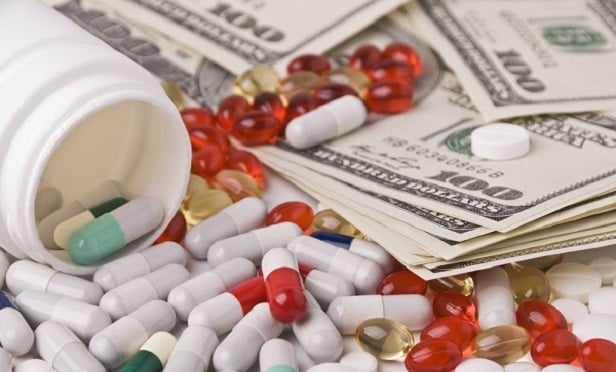 The confluence of significant list price increases, the growth of HDHPs and lightning-bolt stories such as the 500 percent price increase forEpiPen put a tremendous amount of pressure on the rebating system. (Photo: Shutterstock)
The confluence of significant list price increases, the growth of HDHPs and lightning-bolt stories such as the 500 percent price increase forEpiPen put a tremendous amount of pressure on the rebating system. (Photo: Shutterstock)
Clients often ask about the future of drug rebates. How do they keep growing? Are they sustainable?
Rebates have been used by pharmacy benefits managers (PBM), health plans and plan sponsors to partially offset the cost of prescription drugs. In the past, rebates were viewed as a desirable financial component of the PBM pricing equation, however, in recent years rebates are viewed as a necessary evil. Rebates are retrospective discounts off the list price of drugs that PBMs negotiate directly with drug manufacturers. PBM's leverage their aggregate book of business and essentially threaten to move market share away from one manufacturer to another competing manufacturer's product in an effort to lower a drugs price.
Related: HHS secretary Azar calls for 'a system without rebates'
In recent years, formulary drug exclusions embody this process and manufacturers are at risk of being totally excluded from coverage if they cannot get their product's price low enough net of rebates. In fact, CVS disclosed that formulary exclusions will have created $2.38 billion in annual savings (2012-2019) while ESI noted its exclusions were valued at $1.77 billion in annual savings (2014-2019). In the early 2000's rebates were less than 6 percent of drug spend but rebate value has ballooned to over 20 percent of drug spend today.
Did drug manufacturers simply dip into their pockets by 20 percent accepting much lower net prices today than in years past? Of course not. Many argue that manufacturer list price increases are in part driven by PBMs demand for larger rebates. This is a large part of the gross to net conundrum, which is largely driving the pressure to eliminate rebates. Adam Fein, CEO of Drug Channels Institute perfectly described this as “the ever-growing pile of money between a manufacturer's list price for a drug and the net price after rebates and other reductions.”
Data supports that between 2013-2015 net prices (prices paid by PBMs/plan sponsors) trended at 3-5 percent while gross price (price paid by members) trended at 11-15 percent. Further, IQVIA pegs the gross to net value at a staggering $153 billion for 2017. Bottom line, drug manufacturers are passing on huge list price increases to consumers and in turn paying rebates sometimes as high or greater than 50 percent of the list price to PBMs which may or may not be passed on to plan sponsors. Members in high-deductible health plans (HDHP) pay the list price of a drug, however, that price has zero correlation with the true net cost of the drug after rebates (which may not even be passed on to the employer).
The confluence of significant list price increases, the growth of HDHPs and lightning bolt stories such as the 500 percent price increase for the EpiPen put a tremendous amount of pressure on the rebating system. This issue has caught the eye of the Food and Drug Administration, Department of Health and Human Services and, of course, Congress and the White House.
Even as far back as 2016, the commissioner of the FDA, Scott Gottlieb, provided testimony to the Senate Committee on health, education, labor and pensions highlighting the gross to net pricing issue and further discussed a pricing ecosystem that excludes rebates. More recently, Alex Azar, Secretary of Health and Human Services, also promoted moving away from rebates, saying, “We may need to move toward a system without rebates…Such a system's incentives, detached from these artificial list prices would likely serve patients far better.”
Even Pfizer's CEO Ian Reed said he believes “we are going to go to a marketplace where we don't have rebates.” That's a lot of firepower all with the same anti-rebate message – and does not even include President Trump's comments.
A system without rebates would require significant fundamental change to the foundational economics of the drug ecosystem that just about all stakeholders rely on. Such a dramatic change would take years to implement and will certainly have a dramatic impact to PBM pricing as we know it today.
A little-known fact is that employers can in fact choose to have their PBM administer a plan which has rebates applied at the point of sale at the pharmacy to lower the drugs cost for the member. Take a $500 medication that has a $100 rebate. In a typical contract with rebates, a member within a HDHP would pay all $500 while the employer would cash in a $100 rebate check which is typically paid 150 days after the quarter ends (or in many cases the rebate is retained by the health plan or PBM). If rebates were applied to the point of sale, the PBM would immediately lower the cost of the drug by the rebate. In this case, the member would pay $400 and the plan would not receive any rebate dollars.
While the member benefits immediately by the value of the rebate the plan suffers as it loses out on potentially millions of dollars in rebates that were previously used to offset cost and in turn lower the premium employees pay to access benefits. Additionally, it is important to note that the PBM will likely seek additional fees as it loses the time value of money on the rebate dollars. If accounted for correctly, point of sale rebates can successfully align member incentives with plan incentives, however, it is a burden some may not find worth the effort.
One thing is for sure – it's seems hard to believe that PBMs will happily swap rebating for a transparent pricing structure, especially since pharmaceutical revenue (rebates and non-rebate revenue from drug manufacturers) is a significant source of revenue for the PBMs. It's important to note that CVS recently disclosed rebate retention equaled only $300M on $2.4B in profit for Q2-2018 and Cigna disclosed that ESI passes on 95 percent of all rebates to clients (excluding rebate administrative fees and value-based reimbursements which collectively is a large sum of money). In these disclosures, however, there is no mention about non-rebate revenue that is included in their pharmaceutical contracts which is never passed on to plan sponsors.
Looking ahead to the future, there are many potential scenarios that may evolve over time in a rebate free market. Some potential options may include: dramatically deeper discounts that would vary by formulary and essentially replace rebates, (however, technology to administer this is not currently available), incremental drug/plan specific discounts beyond the typical PBM pricing (but again the delivery of such discounts is challenging), some type of at risk or risk sharing contracts (although PBMs traditionally don't like taking on risk) or pay for performance where payments to PBMs increase if certain predefined metrics are hit (which will likely create less options for employers as PBMs would likely mandate certain coverage rules).
Those most at risk are Health Plans, Third Party Administrators or other intermediaries that rely on rebates paid by PBM's as a significant source of revenue. While the rebate bubble will eventually pop, the reality is that when it does it will be a seismic shift in PBM pricing that will take years to fully operationalize.
 Scott Vogel ([email protected]) is a partner at Confidio, a technology enabled pharmacy benefit consulting firm serving millions of members nationally.
Scott Vogel ([email protected]) is a partner at Confidio, a technology enabled pharmacy benefit consulting firm serving millions of members nationally.
© Touchpoint Markets, All Rights Reserved. Request academic re-use from www.copyright.com. All other uses, submit a request to [email protected]. For more inforrmation visit Asset & Logo Licensing.






